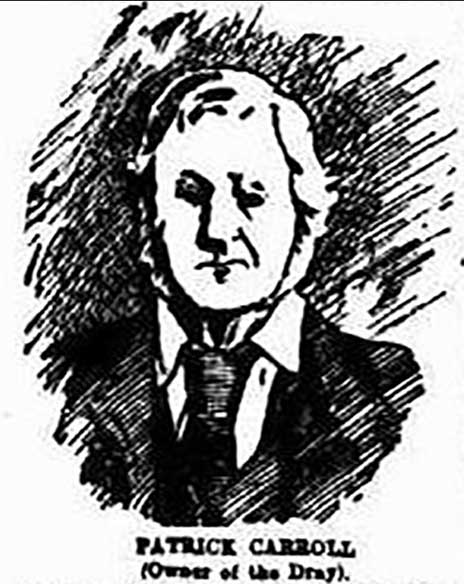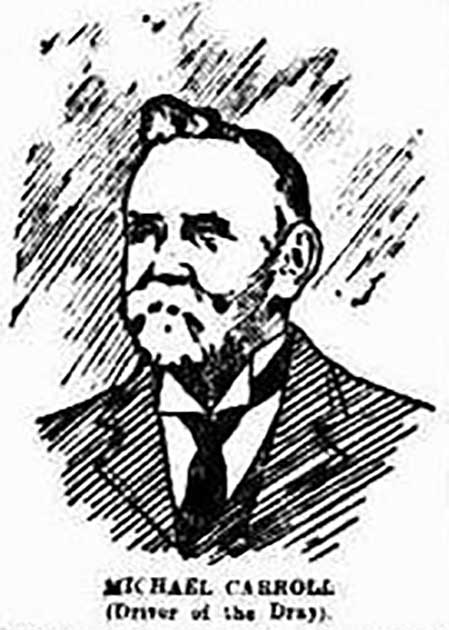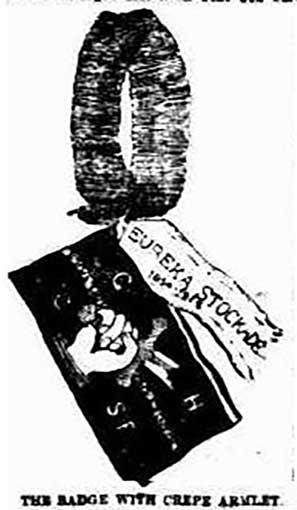Eureka 60, 1914
- EUREKA'S DIAMOND JUBILEE.
- The Stirring Story of the Stockade.
- BALLARAT DIGGERS' FIGHT FOR FREEDOM.
- Peter Lalor's Escape—The Tale Retold by a Participant.

Patrick Carroll, Owner of the Dray. Melbourne Truth, 05 December 1914
- Last Thursday the sixtieth anniversary of one of tho great epoch-making events in Australian history—the fight at the Eureka Stockade. Tho sacred cause of freedom for which the diggers of Ballarat fought and bled—seemingly in vain—is now every-where triumphant in those States, and it is well that Australian patriots should hold in affectionate remembrance the men to whose valiant efforts much of our present liberty is duo. The "Diamond Jubilee" of the Stockade will be fittingly celebrated through-out the Commonwealth. In Melbourne, the Trades Hall Council has arranged for a mass meeting to be held under its auspiccs at the Old Trades Hall on Sunday afternoon, and similar meetings will be held in other centres.
- The Eureka Stockade marked tbe birth of AUSTRALIAN NATIONALISM. When the 10,000 diggers, assembled on Bakery Hill under the rebel flag of the Southern Cross, swore with uplifted hands to defend their rights and liberties even to the death, they lit a flame which shall never die out. The fight which followed on the Eureka Lead on that bloody Sunday 60 years ago was a defeat for the diggers, but it was a defeat which was greater than a victory. Eureka Stockade was the Bunker's Hill of the Australian democracy. The blood shed at Eureka was not shed in vain. Though the diggers were defeated, their cause triumphed. The tyranny and irresponsible authority against which they revolted was swept into oblivion, and a new era of democratic government was inaugurated.

Michael Carroll, Driver of the Dray. Melbourne Truth, 05 December 1914
- Everyone has heard the stirring story of the Stockade; but—"lest we forget"—let us recount it once more in brief outline. The discovery of gold in Victoria led to a vast inrush of fortune-hunters from every part of the world. The miners who flocked in their thousands to the Ballarat fields in the early fifties were regarded as the natural prey of the authorities. They were HARASSED AND HOUNDED on every side. Every digger was compelled to pay a monthly tax of thirty shillings for a mining license. The tax in itself was un-just and iniquitous, but the ruthless man-ner in which it was collected roused the re-sentment of the miners to fever heat. The police organized periodical "Digger Hunts," in which unlicensed diggers were hunted down like dogs, and when caught were chained up like criminals. There was no appeal, for Victoria was then ruled in autocratic fashion by Governor Hotham, a stern old quarter-deck martinet. The police magistrate at Ballarat, who should have been the protector of the miners against, injustice and violence, was a notorious scoundrel named Dowes, who was kicked out of the service shortly before the outbreak. Many another such rascal, "dressed in a little brief authority," added to the burdens the Diggcrs had to bear.
- The breaking point of the diggers' patience was reached in October, 1854, when a miner named Scobie was foully murdered at a dis-reputable hotel kept by one Bentley. Bent-ley was indicted for murder; but, though the evidence was very strong against him, be was acquitted by his friend Dewes, who occupied the bench. The diggers showed their resentment at this by burning down the hotel and forcing Bentley to flee for his life. Of the many thou-sands who took part in this demonstration, three perfectly innocent men were arrested and convicted on perjured evidence. The diggers applied to Governor Hotham, demanding the release of the prisoners. The Governor's reply was to despatch military reinforcements to Ballarat. The soldiers (a detachment of 120 men arrived at Ballarat on November 28, and were given a hostile reception by the miners. On the following day, 10,000 men assembled at Bakery Hill and resolved to pay no more license fees.
- A hugh bonfire was lighted, and each man solemnly cast his license into it. The authorities took up this direct challenge by organising a great "digger drive" next day (November 30), in which 200 armed men took part. After a brief skirmish with the police, the diggers fell back upon the Eureka Lead and made preparations for defence.
- A stockade of logs and slabs was hastily constructed, enclosing an area of about an acre; provisions were laid in, and a black-smith set to work FORGING PIKES, as the diggers were short of arms. In the afternoon a mass meeting was held, at which Peter Lalor, who was now emerging into prominence as a leader of the revolt, administered an oath to the assembled miners, by which they swore to stand together in defence of their rights and liberties. Re-inforcement arrived from Creswick and other mining centres, until the stockade could not accommodate all its defenders. Many withdrew, as it was not expected that the authorities would attack the Stockade until the arrival of the big force of soldiers which was on its way from Melbourne. On Sun-day morning (December 3) only 200 diggers were left in the camp.
- Captain Thomas, who commanded the troops (numbering 276 men) was informed of the situation by his spies, and he seized the opportunity to deliver a surprise attack. Just as dawn was breaking over the lake, the soldiers rushed the Stockade. A death-dealing volley at close quarters mowed down the first line of the defenders, and then the soldiers charged home with the bayonet. The diggers, surprised and out-numbered, fought bravely with their rude weapons—pikes, hatchets, and axes—but the battle was a hopeless one from the start. The fighting was all over in less than 15 minutes. Twenty of the diggers were LEFT DEAD UPON THE FIELD, and eleven others were wounded. The sol-diers lost 6 killed and 12 wounded. Peter Lalor was among the wounded, but his friends assisted him to escape. Twenty of the diggers were arrested and tried for high treason in connection with the revolt: but public feeling ran strongly in their favor, and the jury promptly acquitted them.
- The fight at the Stockade called public attention to the grievances of the miners in a way that could not be disregarded. The obnoxious license tax was abolished, the magistracy and administration were reform-ed, and responsible Government was shortly afterwards established. Peter Lalor, who had not long before been hunted down like a criminal, with a reward of £200 upon his head, returned in triumph to Ballarat, and was elected in 1856 as the first represent-tative of that district in the Legislative Assembly. He rose to be Speaker of the As-sembly and a man of light and leading in the political world. Of such stuff are rebels sometimes made.

Thomas Carroll, Grandson of Patrick Carroll, and son of Michael Carroll. Melbourne Truth, 05 December 1914
- PETER LALOR'S ESCAPE is one of the most dramatic episodes of the Eureka Stockade. The insurgent leader was badly wounded in the arm and left upon the field of battle. His friends concealed him, and later in the day removed him secretly to the tent of his mate, Steve Cummins. There he lay in agony and distress of mind until the following night, when he was taken to the residence of Father Smyth (a prominent figure in those stormy days), where his wounded arm was amputated at the shoulder. The police were huuting high and low for Lalor. but his friends guarded him well, frequentlv changing his place of concealment. Finally, a carter named Patrick Carroll (now gathered to his fathers), who did carrying between Ballarat and Geelong in conjunction with his son Michael (still in the flesh and residing at 12 Pleasant street, Ballarat), volunteered to convey the rebel leader to Geelong. Michael, who was then a sturdy young chap, drove the dray, and successfully accomplished the feat of running the police gauntlet. Lalor lay low with his friends at Geelong until the acquittal of the 12 diggers in the following April made it safe for him to venture abroad once more.
- Michael Carroll, who, by the way, has a son named Thomas, now residing at 6 Mary street, Richmond (to whom we are indebted for the portraits and illustration accom-panying this article), retains a vivid recollecttion of the journey, and often RECOUNTS THE ADVENTURES the party met with on the way. He tells how his father, arriving in Ballarat from Geelong shortly after the Stockade fight, called on an old friend named Michael Hayes. There was a green baire partition at one end of the hut, and behind this Peter Lalor lay hidden, though Carroll was not aware of this until afterwards. When Lalor discovered that the carrier was a man to be trusted, he revealed himself. "Do you know who I am?" he demanded. "Yes," answered Carroll; "you are Peter Lalor." Lalor then asked him to take a letter to the lady be afterwards married—Miss Dunn—who was at that time a schoolmistress at Geelong. It was arranged that if all went well Carroll should take him down to Geelong on his next trip. When Carroll returned, final arrangements were made for the escape, and in due course Lalor was smuggled out of town in the carrier's dray.
- Michael Carroll says he can remember that troopers were up and down the roads and all over the country searching for Lalor, Vern, Black, and other of the Stockade leaders, for whom BIG REWARDS WERE OFFERED. On every second tree thoy passed they saw a proclamation offering rewards of from £200 to £500 for the capture of these men, dead or alive. The little party set out with great secrecy before daybreak, while the camp was still wrapped in slumber. Lalor was concealed under a tarpaulin in one of the draysas they lumbered across the Eureka Lead and out to the Geelong-road. A call was made at Steve Cummin's tent, where Lalor said good-bye to his old mate. A young fellow named Thomas Marks was picked up here, and accompanied the party to Geelong. Carroll was disinclined to take him, but Lalor offered no objection, as he was recommended by Cummins. Marks afterwards claimed the credit of saving Lalor, which was rightly due to Patrick and Michael Carroll.
- As soon as the party was well away from the camp, Lalor got down from the dray and walked most of the way, keeping off the track so as to avoid the troopers if they came along. Fortunately, no police were encountered; but Lalor had a narrow escape from capture on the second morning of the journey. The party halted at Muddy Water Holes (now known as Lethbridge), and Patrick Carroll went over to the Separation Hotel to get some wine for Lalor, who was still feeling the effects of his wound. As he was returning, two men who were camped near by asked him for a lift into Geelong. Carroll refused; but as they passed the dray in which Lalor sat, one of the men RECOGNISED THE REBEL LEADER. He told his mate — a man named Burns — and suggested that they should follow the party to Geelong, give information to the police, and claim the reward offered for the capture of Lalor. Burns, who was a genuine fellow was revolted by the callous proposal, but he pretended to acquiesce in order to save Lalor. He took his mate back to the hotel, plied him with whisky until he was hopelessly drunk, and then ran across and told Carroll of his convoy's danger. Needless to say, no time was lost in making a move. Geelong was reached without further adventure, Lalor was first taken to Miss Dunn's place in Chilwell, and afterwards to the Young Queen Hotel, on Barwon-road, where he remained until the State trials were over and the reward for his apprehension was withdrawn. On his return to Ballarat, he was given a most enthusiastic welcome, and the diggers collected £1,000 to set him up in business. Lalor did not forget the debt of gratitude he owed to Patrick Carroll. He called at the carrier's place upon his return, and thanked him warmly for his LOYALTY AND COURAGE. "We had a grand shake hands," old Patrick told his son, proudly.
- The old veterans of the Eureka Stockade are passing out one by one, and there are now few genuine survivors of that historic event. Australian patriots, while celebrating the "diamond jubilee" of the Ballarat diggers' fight for freedom, should remember to do honor to the few survivors still left in our midst, and also to the loyal and courageous men like the Carrolls, who risked their liberty by assisting in the escape of the insurgent, Peter Lalor.
